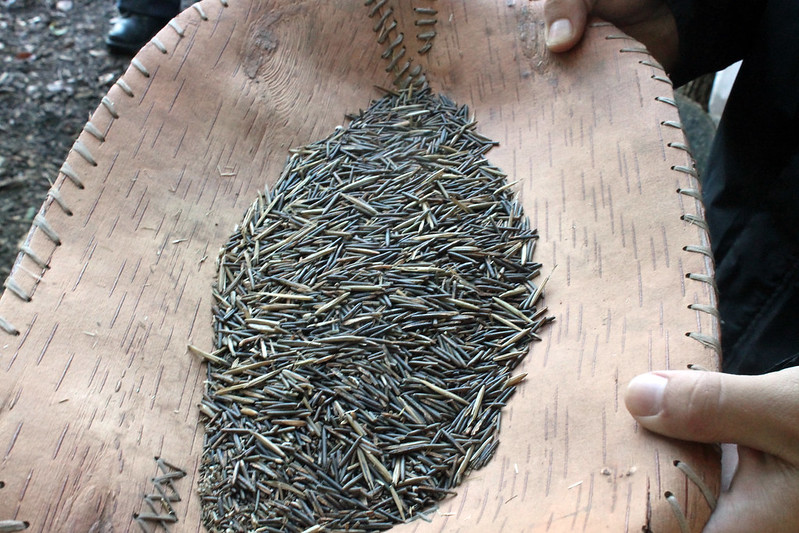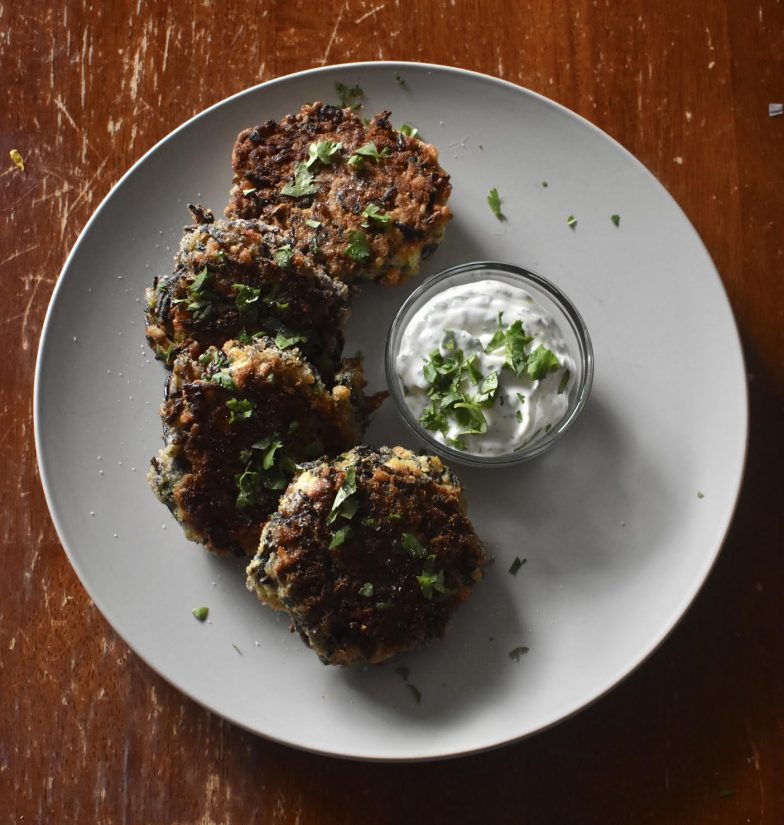An exploration into Anishinaabe food systems – Featuring an adaptation of Freddie J. Bitsoie’s recipe for Manoomin Rice Cakes
Introduction
Our choices about what we consume and where it is sourced can contribute to positive environmental and social change. Last quarter, I published an article exploring sustainable seafood, diving into fisheries, aquaculture, and ethical seafood sourcing, and a delicious recipe showcasing Pacific Rockfish. It was the first installment of a sustainable eating series highlighting various facets of what it could mean to eat with the environment in mind. In the second installment of the series, I focus on Anishinaabe food systems.
This article honors Indigenous food systems for their sustainable nature, but it also serves as an exploratory piece to learn more about the foods and culinary traditions of my Anishinaabe ancestors. The end of the article features a recipe using manoomin (wild rice), a staple to Anishinaabe diets, to deepen those connections and ties with my heritage and home in Michigan. Furthermore, this article uses Anishinaabe food systems and culture as an opportunity to reflect upon and support Indigenous food systems throughout North America.
Anishinaabe activist Winona LaDuke says, “food sovereignty is an affirmation of who we are as Indigenous peoples and a way, one of the most surefooted ways, to restore our relationship with the world around us.”
What are Indigenous Food Systems?
Indigenous food systems are broad, encompassing the food practices of Indigenous peoples across the world. They are all unique and have evolved to specialize in harvesting the plants and animals of their ecosystem. This article will emphasize Anishinaabe food systems of the Great Lakes region, however, Indigenous food systems as a whole bear similarities to one another as they highlight the relationships and reciprocity of planting, growing, harvesting and preparing the foods native to this region prior to settler agriculture. While there have been interruptions to Indigenous food systems through forced removal and relocation of communities, diminished hunting and fishing treaty rights, and U.S. government policies that have contributed to food deserts on reservations, there have also been a resurgence of Indigenous food culture and sovereignty movements through Indigenous farming, seed saving, traditional harvesting, and Native food organizations. Anishinaabe activist Winona LaDuke says, “food sovereignty is an affirmation of who we are as Indigenous peoples and a way, one of the most surefooted ways, to restore our relationship with the world around us.”
Benefits of Indigenous Food Systems
Sustainable food systems typically encourage the purchasing and consumption of locally grown produce, as it is often better for the environment and your health. However, locally grown foods are not always native to the area. Most of the crops grown in the U.S. today have been introduced from other parts of the world. Indigenous food systems, however, often include the reliance on native crops for consumption. In Anishinaabe culture, many of the plants that are utilized for consumption include nuts, berries, greens, onions, leeks, corn, and squash. In addition to crops, harvesting proteins was an incredibly important aspect to Anishinaabe food culture. Throughout the seasons, Anishinaabe communities selectively harvested wildlife such as deer, ducks, moose, bear, pike, walleye, and sturgeon. Some of these food staples demonstrated more significance than others in Anishinaabe diets. For example, sugar maple sap not only represents an important food for the community, but the harvest of sap and its transformation to syrup represents harmony between people and their surrounding environment.
The benefits of consuming an Indigenous diet are numerous, from cultural strengthening to improving public health in communities. Indigenous diets often have fewer saturated fats, more iron, more zinc, and more vitamin A, all of which improve overall health through reducing the risk of diabetes, supporting natural stages of development, and increasing immune system functions. Food is medicine, and for many Anishinaabe communities, returning to traditional diets have aided in reducing childhood obesity and diabetes, while connecting with their culture through food. There are several programs in Michigan and Minnesota that merge the wisdom of the past with the research of the present, highlighting this cultural framework to nutrition lessons.
Within Indigenous communities, the benefits of consuming a traditional diet surpass just nutritional needs. People can unite around traditional diets, as they grow, harvest, and prepare foods together, enhancing the strength of Indigenous cultures by teaching each other through practice. Anishinaabe traditions showcase the strengthening of culture through harvesting manoomin. Ojibwe oral traditions showcase the importance of this crop within the community as well as its role in religious and cultural ceremonies. Additionally, the harvest of manoomin can be a time for socializing, storytelling, and knowledge transfer to younger generations within the community.
There are a variety of ways to support Indigenous food systems, such as sourcing ingredients from Indigenous purveyors, donating money or time to organizations dedicated to improving food sovereignty, or growing food using seeds from Indigenous-owned companies. Participating in Indigenous food systems demonstrates support for Native Nations to continue practicing Indigenous food sovereignty.
Recipe – Manoomin Rice Cakes
As important as it is to recognize the ways in which this country could improve in supporting Indigenous food sovereignty, it is also important to celebrate the ways that Indigenous communities uphold their food traditions and cultures today. One of my favorite ways to celebrate different Indigenous cuisines is to educate myself about the ingredients through creating meals.
I was recently given Freddie Bitsoie’s cookbook, “New Native Kitchen.” In the book, Chef Bitsoie explores Indigenous diets and ingredients across the United States through a multitude of recipes. Having grown up in Michigan, I was very familiar with Indigenous foods of the Great Lakes region, but this book illuminates the beautiful varieties of Indigenous cuisines across the country.

I always enjoy cooking a recipe that showcases the theme of each article of the sustainable eating series. For this article, I wanted to cook a recipe from the book that made me think of home and family, so I cooked the Manoomin Rice Cakes recipe from “New Native Kitchen.” Manoomin translates to “the good berry” in Anishinaabemowin, and is a wild rice found growing in freshwater in the Great Lakes Region. This rice is culturally and spiritually significant for its healing and medicinal benefits, to both Anishinaabe communities and for the connected wildlife. This rice variety can be cultivated, but wild harvesting is the preferred way of sourcing it for Ojibwe communities.
Below is my rendition of Manoomin Rice Cakes. I made some edits to the recipe to ensure I used up older produce in my refrigerator, enhancing the sustainable nature of this meal.

Recipe:
Yields 6-8 servings
Rice Cakes:
6 cups cooked manoomin rice
1 shallot, diced
¼ cup red bell pepper, diced
¼ cup yellow bell pepper, diced
¼ cup sauteed zucchini, diced
2 tbsp dried parsley
2 eggs, beaten
¼ cup canola oil
1 tbsp salt
1 tbsp black pepper
Breading for Frying:
2 cups all purpose flour
1 tsp salt
1 tsp black pepper
2 eggs, beaten
2 cups panko bread crumbs, blended until fine (other fine bread crumbs work too)
¼ cup canola oil (for pan frying)
Cilantro Aioli:
1 cup mayonnaise
2 tsp lime juice
½ cup cilantro leaves, chopped finely
¼ tsp salt
¼ tsp black pepper
- Cook the rice according to package instructions. Add some vegetable stock or herbs and spices of your choosing to give it more flavor.
- Add the steamed rice to a blender or food processor. Pulse the rice a few times until coarsely chopped. Do not over mix.
- Transfer the rice to a large mixing bowl. Add the bell pepper, zucchini, shallot, parsley, egg, oil, salt and pepper. Mix it until combined. Optional: Refrigerate this mixture, as it will be easier to form the rice cakes if cooler.
- Create your breading and frying station. In one medium bowl, add your flour, salt and pepper. In another medium bowl, have your egg mixture. In a third medium bowl, have your fine breadcrumbs.
- Turn your oven on to 350 F. Heat up oil (medium-high temperature) in a large pan on the stove. Make a patty using about three tablespoons of your rice mixture. Shape it into a patty, dip it first in the flour mix, then the egg mixture, and lastly the breadcrumbs. Add that rice cake into a hot pan with oil until it is golden brown on each side before transferring to a lined baking sheet. The rice cakes will finish cooking through in the oven, so just brown the exterior.
- Repeat the process until you are finished with your rice mixture and all the patties are on the baking sheet. Place the baking sheet in the oven for 25-35 minutes. During that time, combine your mayo, cilantro, lime juice and salt and pepper to create your dipping sauce.
- Take the rice cakes out of the oven and serve with cilantro aioli and fresh cilantro garnish. This meal also tastes great with freshly diced tomatoes on top.